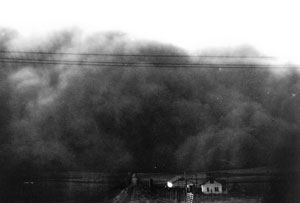No dust storms? Thank an agriculture producer
By Clay Pope, executive director of the Oklahoma Association of Conservation Districts

Oklahoma is once again facing a major drought. Articles in The Oklahoman and other news outlets have described the last four months as drier than any similar period since the Dust Bowl. Every day it seems there’s another drought-related story: wildfires, potential crop failures, no rain. Everything except massive dust storms. Why?
The answer: the farmers and ranchers of Oklahoma and our surrounding states.
We’ve all heard about the Dust Bowl — extreme drought, soil from the southern Plains blowing all the way to the East Coast, massive “dusters” turning midday to night. Surely this year, now identified as one of the driest in Oklahoma history, we should again be seeing massive dust storms. The difference is the changes in agriculture that grew out of the Dust Bowl. These changes resulted largely from the partnership among landowners, local conservation districts and the state and federal governments, especially the Oklahoma Conservation Commission and the U.S. Department of Agriculture’s Natural Resource Conservation Service (NRCS).
Back during the “dirty ’30s,” the government decided it would be better to work with producers instead of against them. Using the open hand of friendship in the form of free technical assistance and financial help in the form of cost-share dollars (helping pay part of the cost of making improvements to the land, the producer then pays the rest) instead of the iron fist of government regulation, the U.S. and state governments worked with producers to turn back the tide of dust. Landowners responded by forming conservation districts and adopting new ways of managing the land, including new tillage practices, experimenting with new crops and by planting marginal land to native or improved grasses.
The results of this partnership? Well, look outside.
Oklahoma was drier in the four months following Thanksgiving than it has been in any similar time frame since 1921. We’re dust storm-free, because of the work done by agriculture producers in partnership with conservation districts and the state and federal governments.
We should be proud of these accomplishments, but there’s more to do. We must stay vigilant and not repeat the mistakes of the past. The state and federal governments must maintain their commitment to conserving our natural resources and properly fund conservation. Cuts currently being proposed to NRCS in Washington should be carefully examined to make sure we aren’t setting ourselves up for a repeat of past problems during this time of tight federal budgets.
We should also recognize that we have new challenges such as water quality concerns and the spread of invasive species like the eastern red cedar, challenges that can be addressed the same way we attacked the Dust Bowl — through voluntary, locally-led means.
By working together we can conserve our natural resources without new regulations. Voluntary, locally-led conservation works. If you don’t believe it, look outside. Do you see a dust storm on the horizon? If not, thank an agriculture producer.
